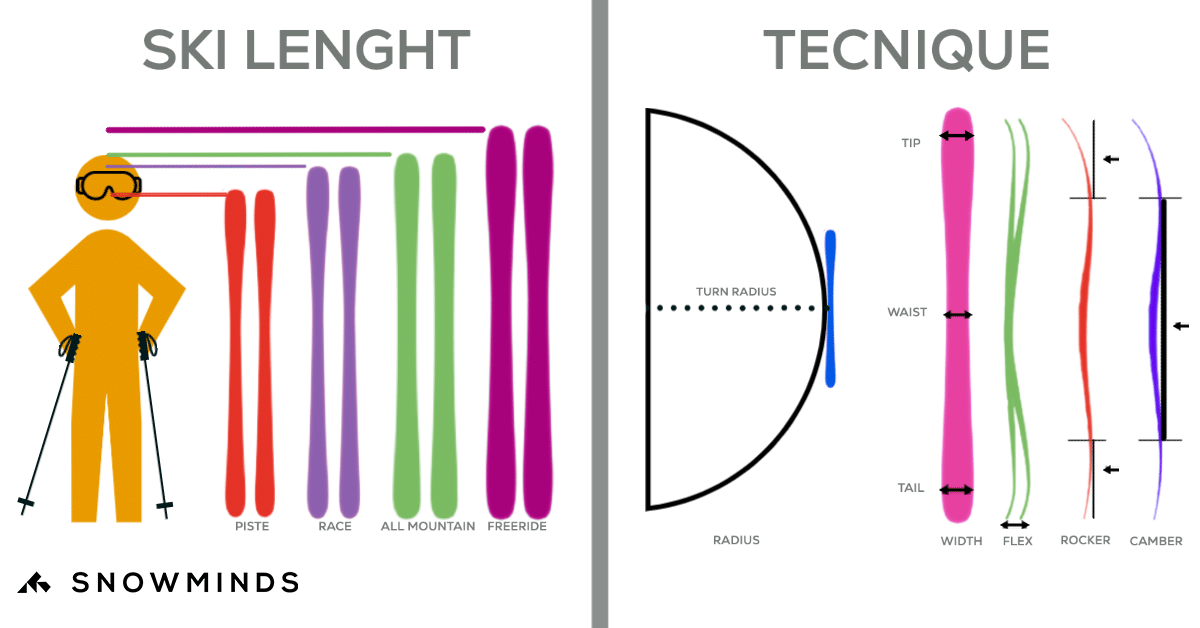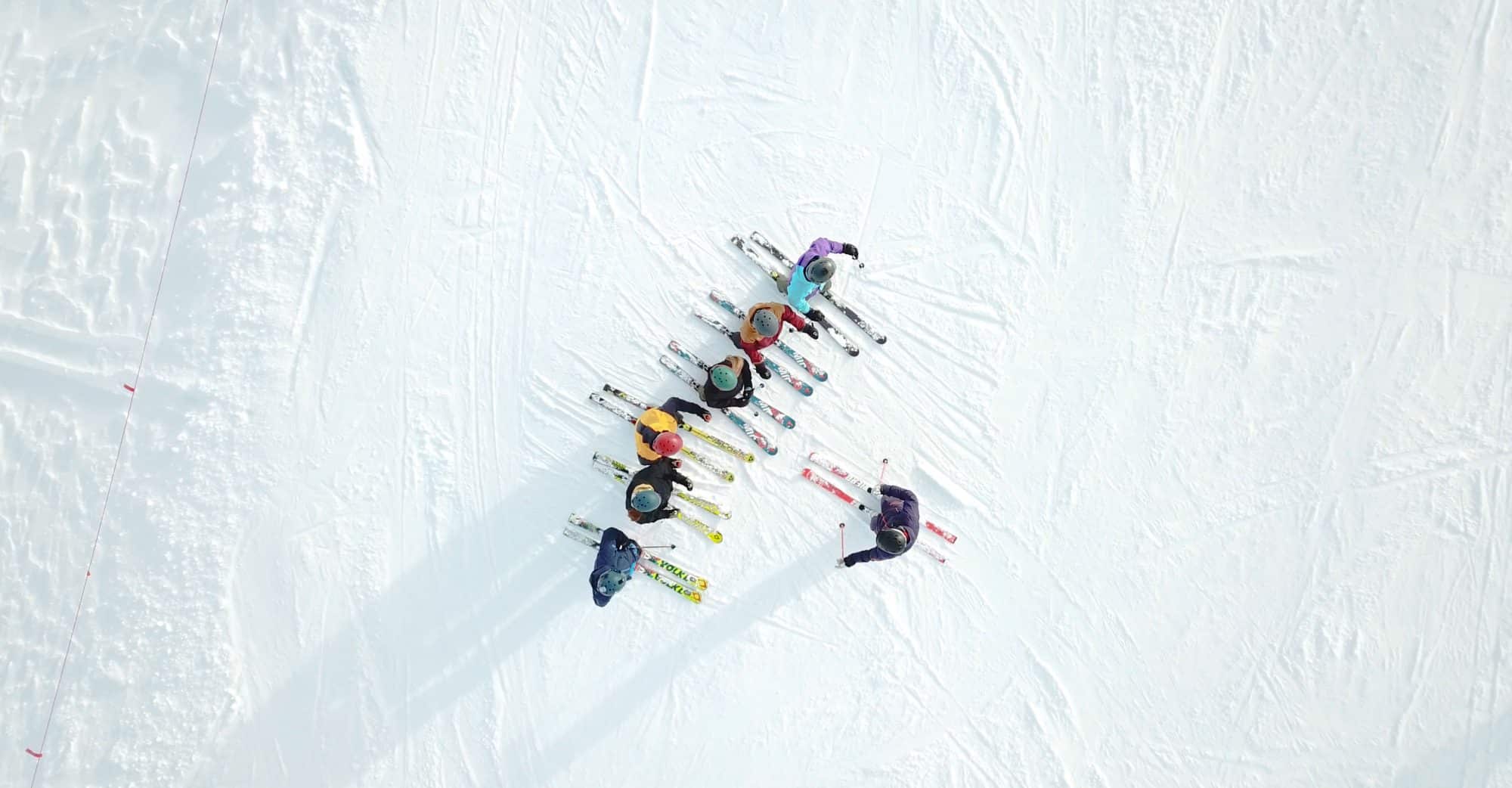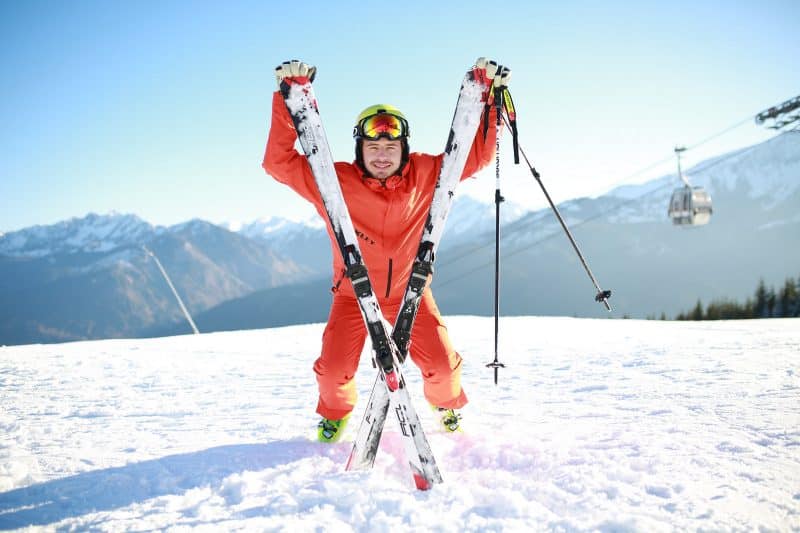BUYING SKI’S – WHAT SKI SHOULD I CHOOSE?
Buying ski’s. Which ski’s should I buy? How tall should my ski’s be? What type of ski is recommended? Is it best to rent ski’s? Where should I buy ski’s? These are question we often are asked. There are so many choices that it can be easy to get lost. Fortunatly, the choice is quite easy if you have the right information. In this blog we explain the differences that you should consider when choosing ski’s.

To keep it simple, we have divided the choices into 2 parts:
- Which type of ski suits me best?
- Which length should I choose?
Which type of ski suits me best?
First of all, it is important to consider what type of ski’s suits you best. That is why it is important to know what type of ski’s that exist. Each brand names the different types of ski’s slightly different, but in general you can divide ski’s into 4 categories:
Piste ski’s
As the name suggests, these are ski’s that do very well on the slopes. They are often a bit lighter, very stable when making carved, short and long turns. In short, it is a real all-rounder that does very well especially on the slopes. Often this is a ski that is a little more forgiving and with which you can easily ski all day without getting tired. Let’s get straight to the point: This is a ski that is ideal for your first season.
Race / FIS Race ski’s
These are the ultimate race monsters. They are stiffer, narrower and made for speed and stability. Nice if you always like to ski on the edge, but they are less suitable for a relaxed and quiet ski days. A real race ski demands more of your technique and strength, which is why we often recommend it to instructors who already have the ambition to learn a lot more and become more technical or perhaps even do a higher education. Do you want a ski that doesn’t need as much work, is a little easier and that you can still ride down the mountain with style? Then a piste ski might also be worth considering.
Freeride ski’s
These are ski’s that excel in the deep snow. They are wide, longer and often less stiff. All properties that help the ski float better in the deep snow, but with which you ski less pleasantly on the slopes. We would highly recommend anyone who enjoys skiing off-piste to bring a pair of freeride ski’s. However, if you take only one pair with you, it is wiser to choose a piste ski, or an all-mountain ski.
All-mountain ski’s
The name says it all, this ski does well all over the mountain. An all-mountain ski tries to combine the best of both piste ski’s and freeride ski’s. They are often slightly longer and wider than piste ski’s, but again stiffer and less extreme than freeride ski’s. This means that all-mountain ski’s can usually do everything fine, but don’t really excel at anything. You can do the training and a season on all-mountain ski’s, but in that case we recommend you to choose an all-mountain ski that focuses a little more on the piste skiing. If you want to get the most out of your development, we recommend that you combine a piste or race ski with a pair of freeride ski’s.
Which ski suits you best as a ski instructor?
Piste ski’s and race ski’s are by far the best for training and a season. If you want a ski where you can do everything and teach with ease, then a piste ski is the best choice.
Is the focus on the other hand entirely on improving your technique, and are you okay with being challenged while teaching? Then a race ski is highly recommended. All-mountain ski’s can also be a great choice, but be aware that in that case you often lose some performance on the slopes, but on the other hand you can ski a little easier off-piste.
Freeride ski’s are a different story. They are not suitable for training, but they are fantastic in the off-piste. Most ski instructors can’t get enough and usually have two or three pairs of ski’s. They often bring one pair ski’s for the piste/training and one pair of freeride ski’s for the deep powder days.
Read more about the different courses here.
 Differences
Differences
Of course, there are also differences within the different ski’s. Think of stiffness, width and radius. Therefore, we will briefly go into a number of these below:
Stiffness: The stiffness of a ski has a major effect on the stability and performance of the ski. Therefore, keep the following rule of thumb in mind: The stiffer the ski, the more performance you can get out of it. On the other hand, a less rigid ski is often a bit more forgiving.
Width: The width of a ski affects your turns and can determine how quick you can switch from side to side and the wider your ski’s are the more they will float when skiing in powder. Freeride ski’s, for example, are very wide and float well, while they do not change sides easily, making short turns more difficult. Piste ski’s are generally narrower and therefore easily make short turns, but float less well in deep snow.
Radius: The radius of the ski indicates how big the curve is when making a turn using the skidesign. For Race ski’s, the radius of the ski determines whether you are talking about, for example, a slalom or giant slalom ski. Typically a shorter radius ski turns slightly easier than a longer radius ski. That does not mean that you can not make short turns with a long radius, you just have to work a little harder for it. When doing your first season, a radius between 12 and 19 meters is fine. Did you already fall in love with a pair of ski’s that don’t have a radius between those numbers? Then ask in the shop what the difference with that specific ski is.
If you want to learn more about choosing the right ski’s, then check out the video below. Keep in mind that the video is made for everyone, and therefore does not specifically focus on choosing a ski for an instructor doing their first season:
Length of the ski
Okay, now you’ve made the choice of the type of ski you want to buy. Now there is one question left: What length should my ski’s be? Manufacturers typically make 4 to 6 different lengths per model.
Because different types of ski’s have different lengths, we recommend that you are well informed about the different lengths. Keep the following rule of thumb in mind: A longer ski is usually more stable and provides a lot of security, while a shorter ski turns more easily and therefore it is easier to make short turns.
Are you going for a piste ski? Then we recommend the ski’s length is around your nose and eye height. If you take a race ski, it depends on the type of race ski. A slalom ski is significantly shorter than a giant slalom ski and therefore the nose/eye rule won’t count. In that case, ask for professional help and be advised in the store.
Where can you buy the best ski’s?
After the summer holidays, Snowminds will open our VIP section on www.snowmindsstore.com, for our instructors, where you can order the latest equipment from Atomic and Salomon for a good price. That’s why we recommend that you wait with purchasing ski’s and equipment when you travel with us, until you see if there is anything that could be tempting.
Salomon and Atomic make it possible for all our instructors to buy ski’s at a discounted price. You will receive information about this after the summer if you are a confirmed instructor.
You will receive information about this if you join us in September, after which you can easily order equipment with a discount. In addition, you could go to your local ski store as well and ask for professional help with the different type of ski that would suit you.
Remember there are always exceptions. So use this article as a guideline!





 Differences
Differences